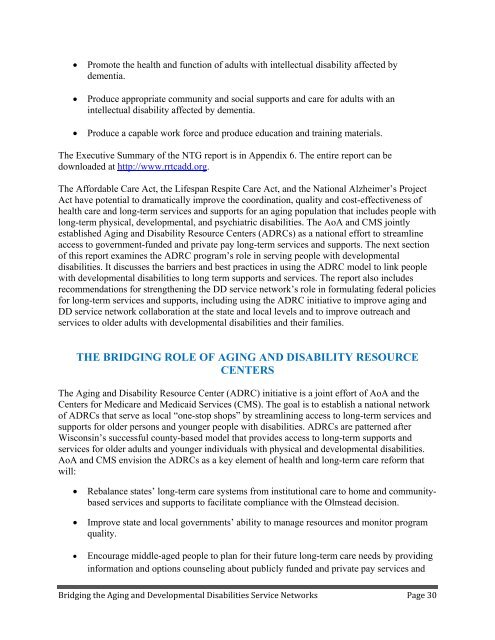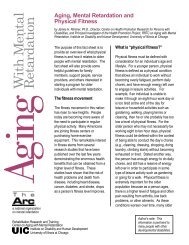Bridging the Aging and Developmental Disabilities Service ... - rrtcadd
Bridging the Aging and Developmental Disabilities Service ... - rrtcadd
Bridging the Aging and Developmental Disabilities Service ... - rrtcadd
You also want an ePaper? Increase the reach of your titles
YUMPU automatically turns print PDFs into web optimized ePapers that Google loves.
• Promote <strong>the</strong> health <strong>and</strong> function of adults with intellectual disability affected by<br />
dementia.<br />
• Produce appropriate community <strong>and</strong> social supports <strong>and</strong> care for adults with an<br />
intellectual disability affected by dementia.<br />
• Produce a capable work force <strong>and</strong> produce education <strong>and</strong> training materials.<br />
The Executive Summary of <strong>the</strong> NTG report is in Appendix 6. The entire report can be<br />
downloaded at http://www.<strong>rrtcadd</strong>.org.<br />
The Affordable Care Act, <strong>the</strong> Lifespan Respite Care Act, <strong>and</strong> <strong>the</strong> National Alzheimer’s Project<br />
Act have potential to dramatically improve <strong>the</strong> coordination, quality <strong>and</strong> cost-effectiveness of<br />
health care <strong>and</strong> long-term services <strong>and</strong> supports for an aging population that includes people with<br />
long-term physical, developmental, <strong>and</strong> psychiatric disabilities. The AoA <strong>and</strong> CMS jointly<br />
established <strong>Aging</strong> <strong>and</strong> Disability Resource Centers (ADRCs) as a national effort to streamline<br />
access to government-funded <strong>and</strong> private pay long-term services <strong>and</strong> supports. The next section<br />
of this report examines <strong>the</strong> ADRC program’s role in serving people with developmental<br />
disabilities. It discusses <strong>the</strong> barriers <strong>and</strong> best practices in using <strong>the</strong> ADRC model to link people<br />
with developmental disabilities to long term supports <strong>and</strong> services. The report also includes<br />
recommendations for streng<strong>the</strong>ning <strong>the</strong> DD service network’s role in formulating federal policies<br />
for long-term services <strong>and</strong> supports, including using <strong>the</strong> ADRC initiative to improve aging <strong>and</strong><br />
DD service network collaboration at <strong>the</strong> state <strong>and</strong> local levels <strong>and</strong> to improve outreach <strong>and</strong><br />
services to older adults with developmental disabilities <strong>and</strong> <strong>the</strong>ir families.<br />
THE BRIDGING ROLE OF AGING AND DISABILITY RESOURCE<br />
CENTERS<br />
The <strong>Aging</strong> <strong>and</strong> Disability Resource Center (ADRC) initiative is a joint effort of AoA <strong>and</strong> <strong>the</strong><br />
Centers for Medicare <strong>and</strong> Medicaid <strong>Service</strong>s (CMS). The goal is to establish a national network<br />
of ADRCs that serve as local “one-stop shops” by streamlining access to long-term services <strong>and</strong><br />
supports for older persons <strong>and</strong> younger people with disabilities. ADRCs are patterned after<br />
Wisconsin’s successful county-based model that provides access to long-term supports <strong>and</strong><br />
services for older adults <strong>and</strong> younger individuals with physical <strong>and</strong> developmental disabilities.<br />
AoA <strong>and</strong> CMS envision <strong>the</strong> ADRCs as a key element of health <strong>and</strong> long-term care reform that<br />
will:<br />
• Rebalance states’ long-term care systems from institutional care to home <strong>and</strong> communitybased<br />
services <strong>and</strong> supports to facilitate compliance with <strong>the</strong> Olmstead decision.<br />
• Improve state <strong>and</strong> local governments’ ability to manage resources <strong>and</strong> monitor program<br />
quality.<br />
• Encourage middle-aged people to plan for <strong>the</strong>ir future long-term care needs by providing<br />
information <strong>and</strong> options counseling about publicly funded <strong>and</strong> private pay services <strong>and</strong><br />
<strong>Bridging</strong> <strong>the</strong> <strong>Aging</strong> <strong>and</strong> <strong>Developmental</strong> <strong>Disabilities</strong> <strong>Service</strong> Networks Page 30



